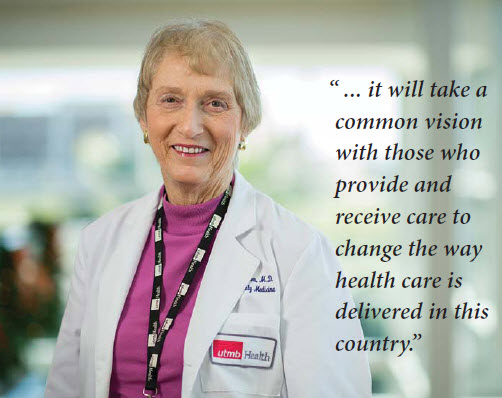
UTMB Family Medicine Chair Dr. Barbara Thompson likes to keep her eye on the future. Although her department recently received the highest level of certification for implementing the Patient-Centered Medical Home model of care, she’s looking ahead—to take a much bigger step that would transform the current health care system, beginning with primary care.
“For years, we’ve been concerned about the American health care system providing the outcomes we want,” said Thompson, who has practiced family medicine for more than 40 years. “As a country we spend a huge amount of money on our health care and still rank low in terms of quality. We need to make fundamental changes to the system, such as placing more value on primary care, building community care systems in partnership with patients and reforming payment systems that are focused on delivering fee for service, rather than improving health.”
As the past president of the Association of Departments of Family Medicine, Thompson was invited to participate on a national steering committee for Family Medicine for America’s Health (FMA-Health), a new collaboration among the nation’s eight leading family medicine organizations to drive continued improvement of the U.S. health care system and demonstrate the value of primary care.
Family medicine leaders recently helped come up with a strategic agenda for FMA-Health’s “Health Is Primary” initiative, a three-year communications campaign that includes six main goals:
- Access. Increase patient accessibility to their primary care team, including remote access to patient records, electronic communication with their care team and availability after hours.
- Engagement. Encourage every practice to have a patient advisory council to facilitate meaningful patient engagement.
- Transparency. Increase transparency in pricing of health care services and educate patients to better understand the cost of care.
- Integration. Integrate public and mental health into the Patient-Centered Medical Home and add care managers, health coaches and population health professionals to the primary care team.
- Recruitment. Support policies that drive at least 40 percent of medical students toward primary care specialties, with the goal of increasing the number of primary care physicians by at least 52,000 by 2025.
- Payment. Sunset fee-for-service payment in primary care. Work with public and private payers to adopt a uniform and simplified model of comprehensive payment that encourages front-end investment in expanded practice infrastructure and technology, rewards Triple Aim goals (better care, better health and lower costs) and supports broad, team-based care. Support efforts to drive the Department of Health and Human Services goal of having 85 percent of Medicare payments tied to quality or value by 2016 and 90 percent by 2018.
UTMB’s Family Medicine Department, with others including Internal Medicine and Pediatrics, is already tackling many of the outlined goals, such as embedding behavioral health professionals in all clinics and increasing access to care by extending hours and providing weekend appointment slots. But Thompson said it will take a partnership with patients and communities, along with collaborators in other specialties and health care professions, to truly achieve meaningful change.
“As family physicians, we are rooted in the communities we serve and provide about one-in-five health care visits, an estimated 214 million office visits annually, so it makes sense that we are leaders in this initiative,” said Thompson. “But it will take a common vision with those who provide and receive care to change the way health care is delivered in this country.”
For more information on the Health Is Primary campaign, visit www.healthisprimary.org.